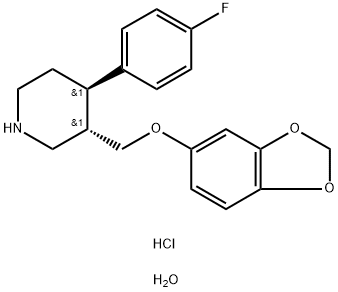110429-35-1
 110429-35-1 結(jié)構(gòu)式
110429-35-1 結(jié)構(gòu)式
基本信息
D4-鹽酸帕羅西汀
鹽酸帕羅西汀半水合物
鹽酸帕羅西汀半水合物, 選擇性5-羥色胺重吸收抑制劑 (SSRI)
(辦證)鹽酸帕羅西汀PAROXETINE HYDROCHLORIDE HEMIHYDRAT
(-)-(3S,4R)-PAROXETINE HYDROCHLORIDE HEMIHYDRATE
(-)-反式-4R-(4-氟苯基)-3S-{[3',4'-(亞甲二氧基)苯氧基]甲基}-哌啶鹽酸鹽半水合物
BRL29060A hemihydrate
PAROXETINE HCL HEMIHYDRATE
Paroxetine-D4 hydrochloride
PAROXETINE-D4 HCL USP/EP/BP
PAROXETINE HYDROCHLORIDE 1/2H2O
paroxetine hydrochloride hydrate
Paroxetine Hydrochloride (350 mg)
PAROXETINE HEMIHYDRATE, EP/BP/USP
BRL29060 hydrochloride hemihydrate
物理化學(xué)性質(zhì)
安全數(shù)據(jù)
上下游產(chǎn)品信息
| 報價日期 | 產(chǎn)品編號 | 產(chǎn)品名稱 | CAS號 | 包裝 | 價格 |
| 2024/11/08 | 46263 | 鹽酸帕羅西汀半水合物 Paroxetine hydrochloride hemihydrate, 98% | 110429-35-1 | 1g | 602元 |
| 2024/11/08 | 46263 | 鹽酸帕羅西汀半水合物 Paroxetine hydrochloride hemihydrate, 98% | 110429-35-1 | 5g | 2055元 |
| 2024/11/08 | P1977 | 鹽酸帕羅西汀 半水合物 Paroxetine Hydrochloride Hemihydrate | 110429-35-1 | 1g | 70元 |
常見問題列表
IC50: 14?μM (GRK2)
Paroxetine (1?μM and 10?μM) distinctly restrains T cell migration induced by CX3CL1 through inhibiting GRK2. Paroxetine inhibits GRK2 induced activation of ERK. Paroxetine (10 μM) reduces pro-inflammatory cytokines in LPS-stimulated BV2 cells. Paroxetine (0-5 μM) leads to a dose-dependent inhibition on LPS-induced production of TNF-α and IL-1β in BV2 cells. Paroxetine also inhibits lipopolysaccharide (LPS)-induced nitric oxide (NO) production and inducible nitric oxide synthase (iNOS) expression in BV2 cells. Paroxetine (5 μM) blocks LPS-induced JNK activation and attenuates baseline ERK1/2 activity in BV2 cells. Paroxetine relieves microglia-mediated neurotoxicity, and suppresses LPS-stimulated pro-inflammatory cytokines and NO in primary microglial cells.
Paroxetine treatment obviously attenuates the symptoms of CIA rats. Paroxetine treatment clearly prevents the histological damage of joints and alleviates T cells infiltration into synovial tissue. Paroxetine reveals a strong effect on inhibiting CX3CL1 production in synovial tissues. Paroxetine (20 mg/kg/day) reduces the myocyte cross-sectional area in rat and ROS formation in the remote myocardium. Paroxetine reduces the susceptibility to ventricular tachycardia. Paroxetine treatment following MI decreases LV remodeling and susceptibility to arrhythmias, probably by reducing ROS formation. In CCI paroxetine-treated group, paroxetine (10 mg/kg, i.p.) produces hyperalgesia at days 7 and 10 (P<0.01), but a decrease in pain behavior is seen at day 14. Moreover, paroxetine (10 mg/kg) significantly attenuates tactile hypersensitivity when compared to CCI vehicle-treated group.

